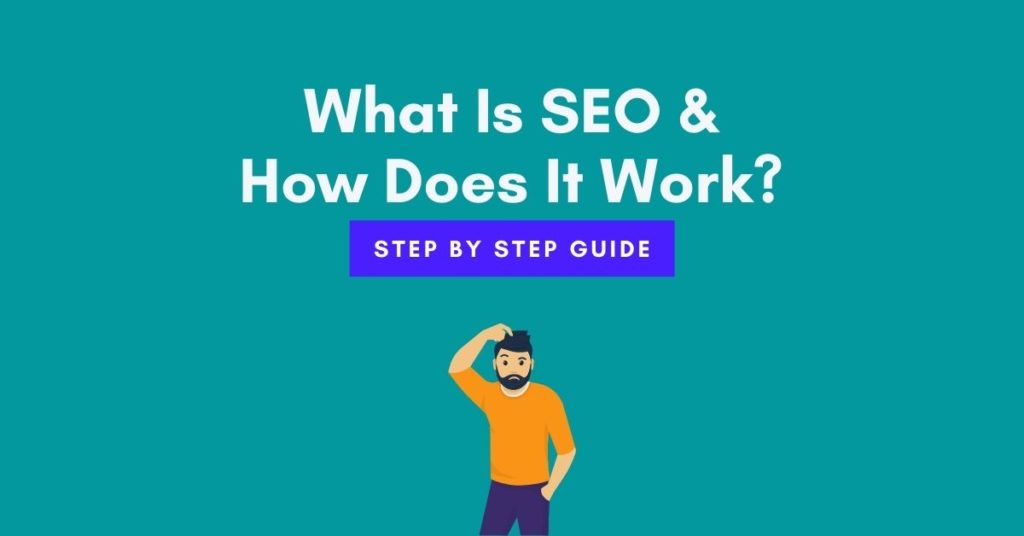
In this step-by-step guide, I will help you understand what is SEO and how it works.
I will explain how search results appear in Google and how you can increase your visibility in search results.
SEO is a very powerful skill to have since every industry in the world can profit from it.
If you are interested in making income as a freelancer. SEO is a thriving business. Let’s get started.
- What is SEO?
- What is on-page SEO?
- What is technical SEO?
- What is off-page SEO?
- Featured snippets
- What is Schema?
- Google image SEO
- Video SEO
- Google Knowledge Graph
- News SEO
- Local SEO
- New Google search features
- Additional Google search features
- How to remove Google search results
- What is Reverse SEO?
- Why would you want to remove search results from Google?
- 16 SEO best practices
What is SEO?
SEO stands for search engine optimization, which applies specific optimizations to web pages that target specific search queries.
How does SEO work?
SEO is a simple concept. The goal is to appear higher in search results over competitors for specific keywords.
By appearing higher in search results, you can garner more clicks, thus leading to more customers.
SEO has three main pillars for the optimization of web sites, which are:
- Onpage-SEO
- Technical SEO
- Off-page SEO.
I will touch on all three tiers within this step-by-step guide. First, let’s dig a little deeper into the process of how a web page appears in a search engine.
How web pages appear in search results
- Web page is published on your website.
- Search engines crawl your webpage to understand your topic.
- An algorithm determines your rank in search results.
- Your web page is indexed in the search results.
- A user enters a query that directly correlates to your topic.
- The search engine displays your page in search results.
Now that you have a top-level understanding of SEO and how it works, and how web pages populate in search results, let’s discuss publishing a web page as a prerequisite.
To appear in Google search, you will, of course, need to create a website or start a blog to publish posts and articles.
If you have a pre-existing website, you can create a blog as a natural extension of your site.
I highly suggest doing this to help you with SEO. I will dive in a bit deeper later on how blog posts help with SEO.
Submitting your site to Google search
To notify Google of your site to index your web pages faster, you will have to do two things.
- Create an XML sitemap.
- Submit your XML sitemap to Google in the search console.
To create a sitemap, you can use a WordPress SEO plugin called all in one SEO pack plugin. Creating a sitemap does not require code to set up.
I recommend paying the one-time yearly fee to take advantage of all the additional features this plugin offers. It is well worth the investment to help you with SEO.
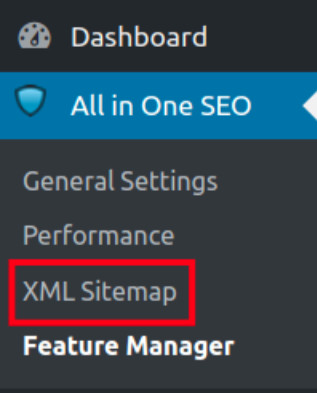
Your sitemap URL address should look like the following:

Once you generate the sitemap from the plugin, drop in the sitemap URL in the Google Search Console.
I will go more in-depth to explain what is Google Search Console and how you can further utilize this tool to aid your SEO efforts later on in this guide.

How to improve SEO on Google by blogging
Creating multiple blog posts that speak to your site’s main topic to increase your indexed pages in the S.E.R.P (Search Engine Result Pages) is highly advised.
Here is a visual example of how this would play out typically. Keep in mind this translates to every vertical, not just digital marketing.
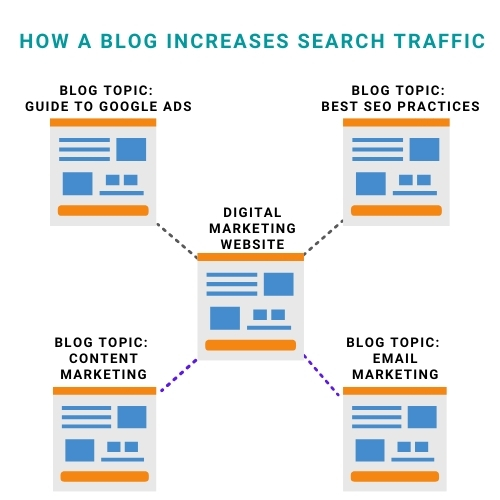
The example above is the basis of creating a blog for SEO purposes. The goal is to target specific keywords with individual posts.
Blog posts extended your keyword reach, increasing your ability to appear in search results for various keywords related to your main topic.
Did you know that websites that have a blog have 434% more indexed pages?
If you are considering creating an ecommerce site, I recommend you start a blog as soon as possible since it is hard to rank for keywords on product pages.
Creating blog topics that you can internally link to product pages is the best way to compete in the ecommerce space with SEO.
Here is an excellent example from Tommy Johns, who happens to be a former client I represented for CRO (conversion rate optimization). Tommy Johns is a big player in the undergarment industry online.
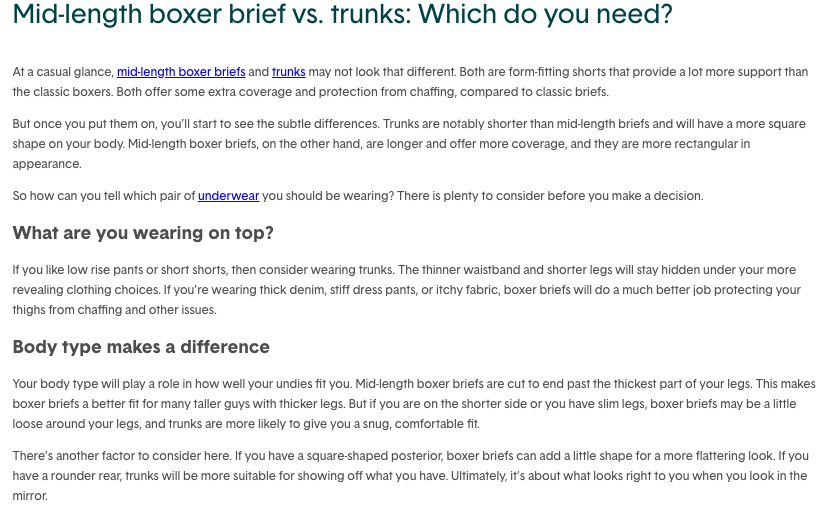
Each blue link in the image above navigates visitors to an internal PDP (Product Description Page) for specific keyword targets.
When a search query is typed into Google for a keyword related to boxer briefs or trunks, they could land on this specific blog post.
Once a visitor lands on the blog post, a click could occur on one of the internal links to navigate the visitor to a product description page.
Once the visitor lands on the PDP you have the opportunity to convert visitors into a paying customer.
What is on-page SEO?
On-page SEO targets specific keywords mentioned within the content of a webpage.
To perform on-page SEO, insert your target keyword in your post title, within your post body, and within your subheadings.
Using an SEO tool called SEMrush, you can gauge the level of search volume the keyword generates per month.
The goal is to insert keywords into your content that carries a good search volume with low competition.
Take a look at the example below of how on-page SEO works in unison with blog posts.

Share this Image On Your Site
SEO benchmarks
As shown in the example, the average industry benchmark for e-Commerce stands at 2%.
This conversion rate will vary across different verticals. As mentioned in the infographic CTR (Click Through Rate) in the number 1 position stands at 31.7%.
Why such a low percentage? Google ads take the rest of the clicks since they are displayed above the organic search results.
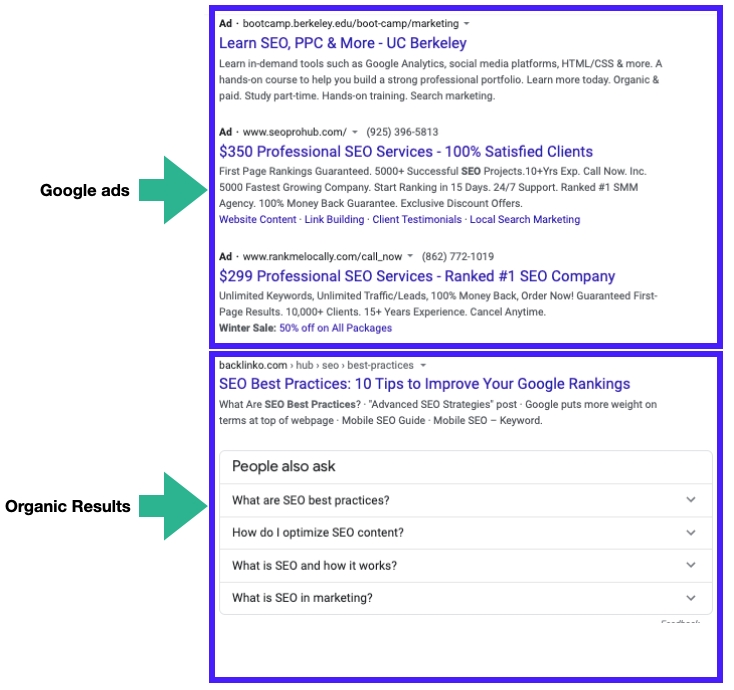
Growth hack tip #1:
Don’t target keywords that have too many Google ads populated to increase your organic CTR ( click-through rate).
The profitability of on-site SEO
If you were to take the example from the infographic and created ten posts, you could potentially generate $4,080 per month in revenue.
But here is the caveat, you would have to have the same ranking position, search volume, and CTR ranking number one for all your posts.
Ranking number one for all your target keywords is not realistic with low-quality posts.
Don’t produce several low-quality posts for indexing purposes. It won’t work, you will not rank, and you will not drive any sales.
The only way you can win is to produce high-quality posts, post regularly, and select keywords with a good search volume with low competition.
Do not make the mistake of targeting the highest search volume keywords that will be too hard to rank. To gauge the competition level, utilize the keyword difficulty metric from SEMrush.
The keyword difficulty is graded on a scale from 1-100. From my experience, targeting a score between 40-59% in keyword difficulty is the sweet spot. Here is a break down of the keyword difficulty levels.

You want to have some competition but not too much to increase your odds of ranking.
As I stated, three tiers to SEO exist. Let’s go over technical SEO and off-page SEO next.
What is technical SEO?
Technical SEO focuses on increasing your page load speed, submitting a robot text file, fixing broken links, and much more. Don’t worry if you are not technical. A lot of free and paid plugins can do most if not all the work for you.
You need technical SEO to give clarity to search engines of how they should crawl and index your site.
What are the essential aspects of technical SEO?
As a rule of thumb, it is best to address seven critical areas with technical SEO.
- Make sure you are using HTTPS
- Check and fix duplicate content
- Submit a robot text file to Google search console
- Improve site speed
- Fix broken links
- Make mobile-friendly web pages
- Add schema (I will speak in-depth about this later on in the guide)
If you are unfamiliar with what I have listed, let’s walk through each one.
What is Https?
HTTPS stands for Hypertext Transfer Protocol. It is used for secure communication over the internet. If this message appears:

Your site needs the HTTPS protocol.
How to implement HTTPS
To implement HTTPS, which is a ranking factor. You will need to have a hosting provider.
I recommend Bluehost as a hosting provider for any new blogger or prospective site owner. Once you access the Cpanel, you can enable HTTPS by clicking a toggle called SSL, which stands for socket security layer.
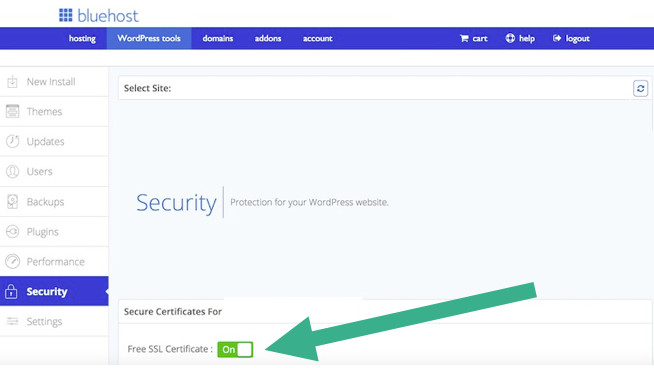
What is duplicate content?
Duplicate content is content that appears on more than one web page.
Ideally, unique content should exist on individual web pages. Having duplicate content confuses search engines on which post/article should be indexed.
How to Check for duplicate content
To check for duplicate content, download free software called Screaming Frog. Once you have done that, click “configurations” then “duplicates” in the top navigation.
Once you do this, a new tab will appear called “content ” to display any duplicates on your site.
This is a paid feature of the tool, but I strongly recommend this tool for SEO in general. The free options are just as useful for SEO.
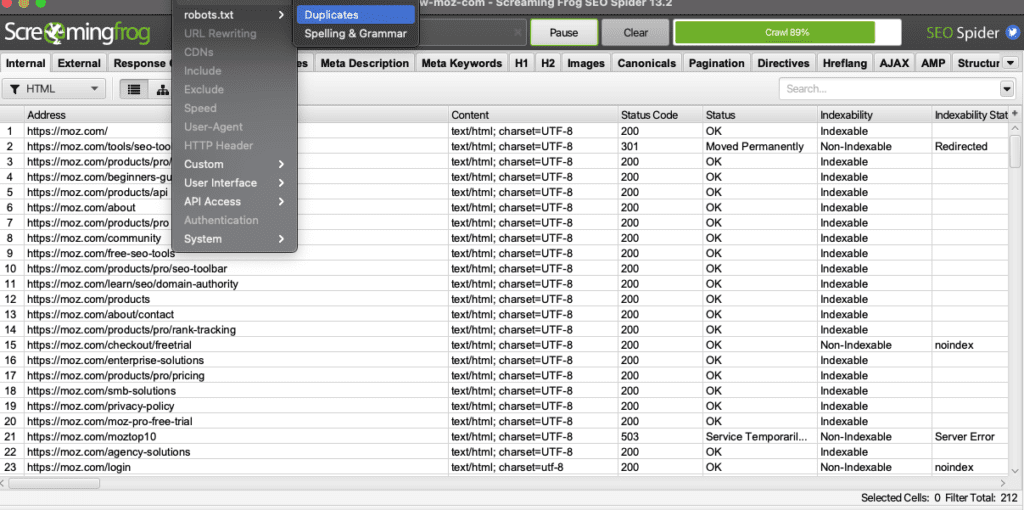
Once you identify pages with duplicate content, you will have three options to fix the duplicates.
- Set up a no-index tag in your robot txt file for the duplicate content.
- Set up a 301 redirect from the “duplicate” page to the original content.
- Apply a rel canonical tag
In most cases, I recommend deploying a canonical tag as your first option and a 301 as your second option. Lastly, no indexing if necessary.
What is a rel canonical tag?
A rel canonical tag tells search engines that a specific URL is the most vital version to be referenced.
Using the all in one SEO pack plugin, you can easily set canonical tags without any code.
What is a robot.txt file?
Robots.txt file is a file that contains rules for web crawlers. It specifies how to inform web robots (search engines) of what should be processed vs what should not be processed.
Setting up and Submitting a robot txt file
To set up and submit a robot text file to Google and perform the other actions I listed above, use the all in one SEO pack plugin for WordPress.
You can get up in running with a few clicks. I recommend the paid plan for the additional features that will significantly help you with SEO.
Improving page load speed
To improve your page load speed, utilize the Google page speed tool, and speak to your developer to implement all suggestions listed. Page load speed is a ranking factor.
Fix broken links
To fix any 404 links, you will need to apply a 301 redirect that can be handled from a WordPress plugin. A good broken link checker and redirection tool to look into is called 404 to 301.
Implement Mobile best practices
To ensure you are following best practices for a mobile-first experience, make sure to utilize Google’s mobile testing tool.
If you need to implement something out of your skillset, turn to fiver.com for a quick development task that won’t break the bank.
Implement schema
I will explain what schema is and why it is highly essential for SEO later within this guide. But in short, schema helps your site stand out in search results.
The best way to implement schema is to use the schema pro plugin for WordPress. It requires no code. More on that later, but for now let’s move on to off-page SEO.
What is off-page SEO?
Off-page SEO refers to any action taken outside of your website to increase your rankings in search results. Off-page SEO is primarily rooted in link building efforts.
What is link building?
Link building is the foundation of increasing the authority of your site. The act of link building involves strategically getting your site mentioned on highly authoritative sites within your niche. There are several ways to go about link building.
Your site will never appear high in search results if you don’t have more popular sites link to your site.
Having a link inserted on more popular sites within your niche is a way for Google to see that these sites vouch for you as an expert in your respective field.
Now that I have covered the three tiers, you must understand what specific search features populate in Google search results.
I will dive into every search feature that is displayed when specific search queries are entered.
I will explain each one so you can learn how to position yourself to appear within these search features to beat your competition in search.
Zero click search results
Have you ever seen the following search result displayed for a question you might have asked before in Google?
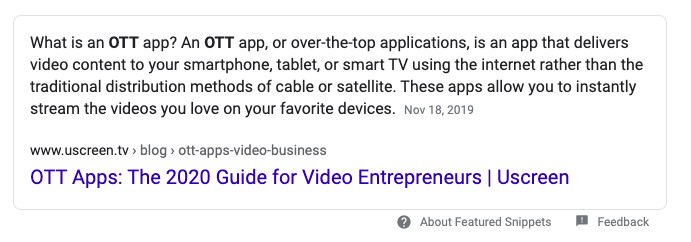
Zero click results display the answer to a question without a click on a search result, so no click occurs; hence the name Zero click search result.
Google directly engineers these results to answer questions.
Featured snippets
Based on a specific question-based search query entered, you will see the following.
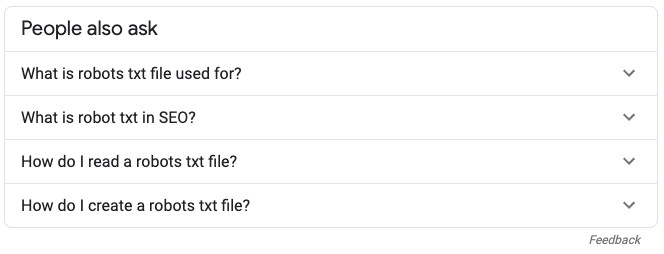
These results are populated to further aid you in finding an answer to a specific question.
SEO professionals call this the Google answer box or featured snippets. Google featured snippets heavily rely on schema markup to appear in search results.
If you are unaware of what schema is, don’t worry, I will explain shortly. But first, let me explain some details about featured snippets.
What is a featured snippet?
A featured snippet can appear as a brief answer to a query entered into Google search. Featured snippets also can appear as reviews, videos, recipes, and much more based on the entered search query.
Featured snippets reference relevant web pages about the entered search query to display the most relevant result.
Why are featured snippets important for SEO?
Featured snippets can help increase CTR (Click-Through-Rate) on search results for specific search queries.
An increase in CTR can produce an overall increase in website traffic to particular web pages referenced from Google to be featured.
How to get a featured snippet in Google
To get indexed as a featured snippet, you will have to implement schema markup code on your webpage. To implement schema without code, I recommend using the schema pro plugin.
What is Schema?
Schema markup is a semantic language for search engines to read to give additional context to web pages.
Schema markup code has several specific markup types to be potentially featured in search results E.g., How to guides, recipes, review stars.
Here are three visual examples of what specific search results that contain schema markup types look like. Click the drop-down button to see each markup type.
How to schema
If you have a specific set of instructions for users to follow, you can directly implement instructions in Google search results.
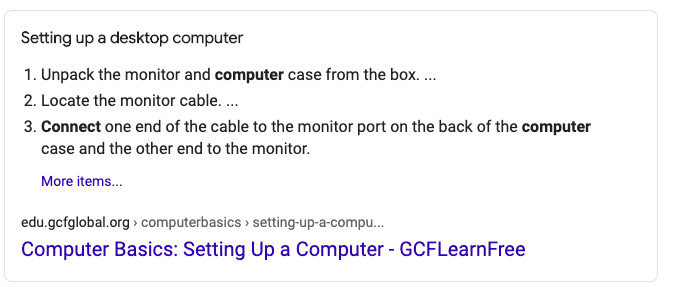
Recipe schema
If you have a food blog, you will significantly benefit from implementing the recipe schema markup type.

Review schema
If you write reviews on your site, you can make your webpage stand out in search by applying review schema markup.

I highly recommend using the schema pro plugin. Using the plugin, you will be given support for multiple schema markup types that you can easily add to any WordPress site with a few clicks.
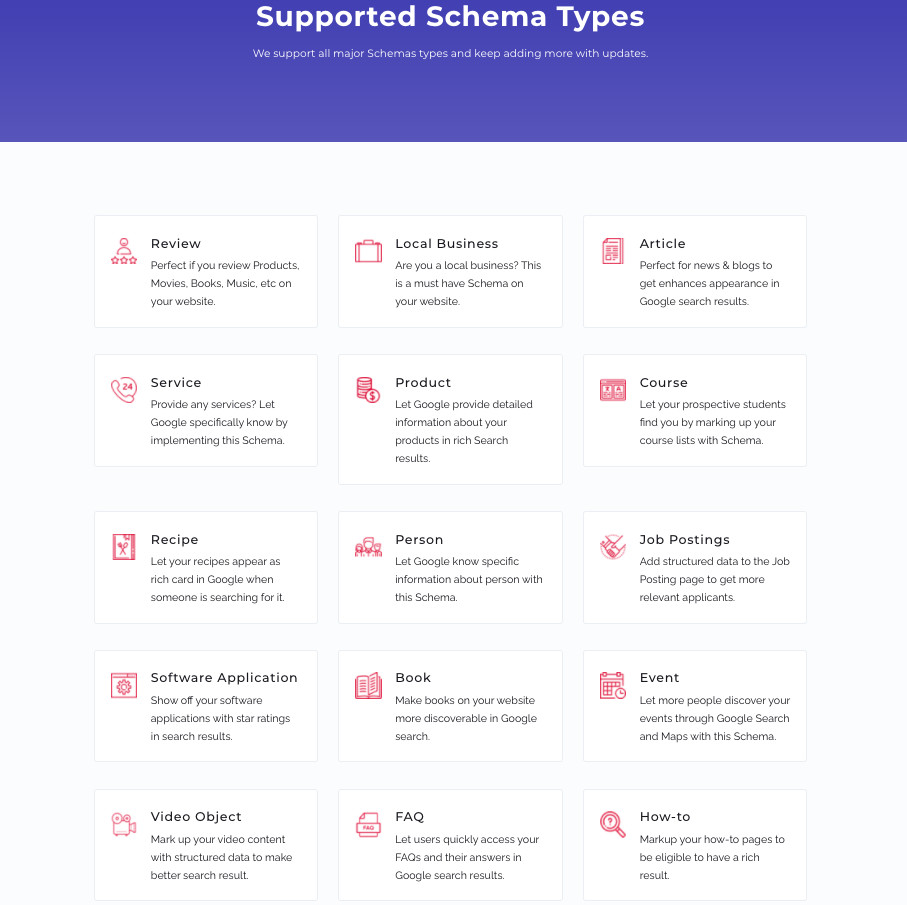
What percentage of search results feature schema?
A study conducted by Ahrefs showed 30.9% of the number one positions in Google contains schema featured snippets.
The data is pretty clear. If you are not implementing schema markup, you will be losing out on producing traffic to your site.
Once you implement schema, I recommend configuring Google search console to monitor how many schema feature results populate in Google.
What is Google search console?
The Google Search Console is a free web-based service by Google that allows webmasters to check various factors that affect your site’s indexing in Google.
To configure the Google search console, you have to copy and paste a code onto your site. To add the code takes no technical skill. Simply copy and paste it.
Don’t be alarmed if you don’t see the enhancements drop down in Google Search Console. Enhancements will only populate once schema is implemented on your site.
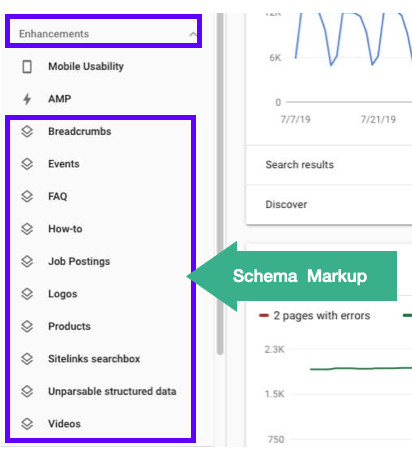
How to monitor Google rankings
To monitor SEO performance, use the SEMrush SEO rank tracker. You will want to see how your ranking positions change over time from implementing schema.
Additionally, SEMrush can show you how many featured snippets are displayed in Google for your site and your competitors.
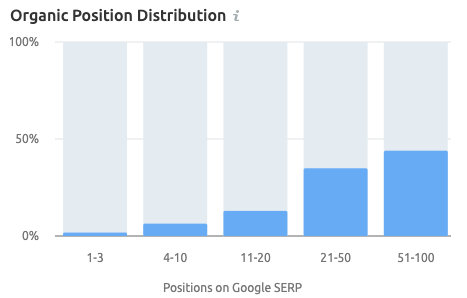
How to spy on competitors
Enter your competitor’s domain name in SEMrush, and it will show you the number of keywords that produce a schema result in Google.
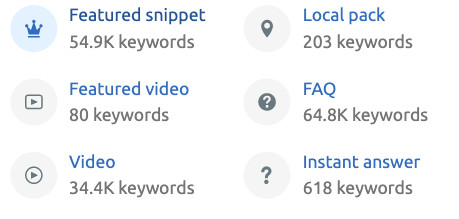
Google image SEO
If you have entered specific search terms into Google search, you may see a collection of images that look like the following example below.

Google displays a collection of images that are relevant to the search query entered.
Having images appear in organic results is just as crucial as having text-based search results appear.
Images are captivating and can entice users to click at a higher rate. Furthermore, image search is estimated to represent 27% of all queries generated.
How to appear in organic Google image results
- Add alt text to your images
- Compress file sizes
- Upload an image sitemap
- Use jpeg image format
Image Alt Text
Alt text stands for alternative text. By default, numbers appear for image file names.
It is a best practice for SEO to replace those numbers with a specific name for what the image is depicting for your alt text.
Image file compression
Google wants to index images, but only if the images are correctly optimized.
Most image file sizes can benefit from being compressed. By compressing images, you will reduce the file size of an image.
You will also increase page load time by decreasing the time it takes for Google to render images.
Google has stated that page load time is a ranking factor. To compress your images, use the WP smush plugin.
Image sitemaps
Many webmasters are unaware of image sitemaps, which will significantly increase your odds of your images being populated in Google.
Image sitemaps are differentiated from standard XML sitemaps by exclusively focusing on the images on your site.
An image sitemap gives Google a directive to crawl images to be referenced for inclusion in the organic image pack results and Google image results.
To create an image sitemap, you can leverage a free online image sitemap tool.
Once you have generated your image sitemap, you will want to log into the Google Search Console and upload your image sitemap for inclusion.

What is the best image file extension to use for SEO?
The Jpeg image file extension is one of the best file extension from an SEO perspective.
Jpegs allow more compression, thus reducing the page load time to render images.
To check your indexed images on your site, turn to the Google Search Console, navigate to performance, and turn the search type to image.
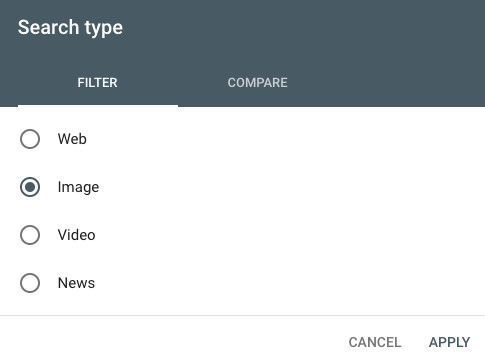
WebP is also a new image standard that is great for SEO. A lot of WordPress plugins can help you convert Jpegs and Png files to the new Webp standard.
Video SEO
Video search results will only become more important over time since Youtube is the world’s second-largest search engine.
Seeing that Youtube is owned by no other than Google, you can surely bet this will only trend up.
Check out these statistics provided by Oberlo.
So given these metrics, it is time to make some videos. Take a look at video search results that are displayed in Google search results.
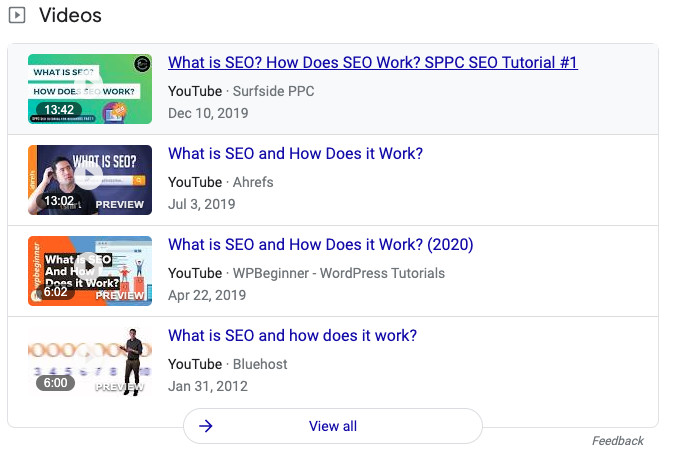
The videos are indexed with the help of the schema video object markup. When creating videos, you can also produce a video sitemap to be crawled by Google to consider indexing in search results.
Once you have made your video sitemap, navigate to sitemaps in the Google search console, and add it for discovery.
As a best practice for video SEO, try to get other sites linking to your webpage where your video is embedded.
Additionally, before you upload your video sitemap, make sure to follow the best practices for optimizing the video by doing the following.
Video SEO best practices
- Include your target keyword in the title tag of your video.
- Make eye-catching video thumbnails to increase your CTR.
- Find tags your competitors are using and include them in your videos.
- Research keywords your competitors are targeting and go after them.
- Upload a transcription to rank for keywords that are in a text format.
Google Knowledge Graph
I am sure you have seen the following feature in search results displayed at least once, right?

What you are seeing is the knowledge graph in action. It is also referred to as the Google Carousel.
How about a search result that looks like this.
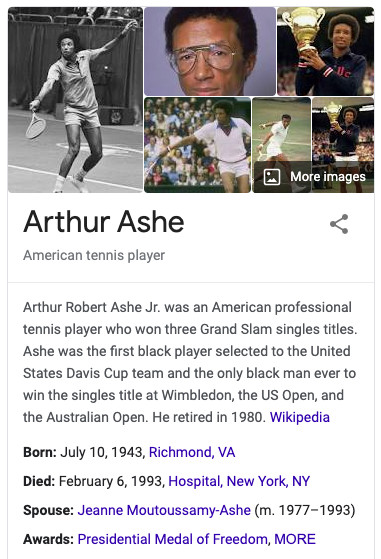
What you see here is the Google knowledge panel.
What is the Google knowledge graph?
The knowledge graph is a collection of data queried from authoritative websites. Information is presented above search results for quick accessibility.
What is the Google Knowledge Panel?
Similar to the knowledge graph, the knowledge panel collects data queried by Google.
The knowledge panel is differentiated from the knowledge graph by displaying dynamic search results to the right side of organic search results.
Usually, the knowledge panel displays information about public figures and large organizations.
How to appear in the Google Knowledge Graph & panel
1.) Create a page on Wikipedia
Wikipedia is highly regarded as an authoritative source. When most search queries are entered into Google, Wikipedia is the top result. It is common knowledge with SEO professionals that Google Knowledge Graph pulls user-generated entries from Wikipedia.
2.) Create a page on Wikidata.org
Similar to Wikipedia, Wikidata.org is open to the public as an open-source project. Wikidata is also seen as an authoritative resource in the eyes of Google.
3.) Create social media profiles
Google shows social media links in Knowledge Graph search results.
Create profiles for the following social media outlets.
4.) Implement Schema markup on your site
Schema markup gives additional context to search engines for indexing. It is essential to add schema to provide a directive for Google to index you in the knowledge graph and panel.
5.) Format your web page
Write for your audience, not search engines. Include the essential information that pertains to the target search query that you want to appear for.
Make sure to:
- Add an explanation of who you are in your about page
- Include links from authoritative web pages
- Embed images, graphics, and videos
6.) Use specific keyword targets
The knowledge graph is populated from queries entered into Google, so it is essential to include your target keyword.
Make sure to:
- Place your target keyword in your URL
- Include your target keyword in your title tag
- Add your target keyword in your meta description
- Add your target keyword in your Heading tags
- Include an introduction, body, and a conclusion
Don’t go overboard with keywords. The goal is to maintain a delicate balance of mentioning keywords while offering value. Write for humans, not search engines.
7.) Promote your content
Content is useless unless you promote it. Make sure to use social media to spread the message about your content.
Shopping search results
The search results that are displayed for product-specific search queries are ads.
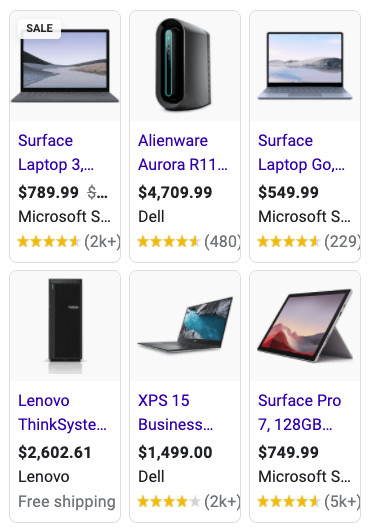
To be featured within Google shopping, you will need to invest in creating a Google shopping campaign.
I recommend when running ads that you test a small daily spend before you invest a considerable sum upfront.
I suggest $10- $20 per day to gauge the traffic that converts for you for one to two weeks. This will significantly vary based on your CPC (Cost per click) for your specific keyword targets.
How to set up a Google shopping campaign
- Navigate to Google Ads
- Select “Campaigns”in the page menu
- Click the plus button, then select “New campaign”.
- Choose “Shopping” as your Campaign type and then click “Next”.
- Set up your advertising preferences
- Next, choose what kind of ad group you would like to create
- Hit Save, and your all set
News SEO
One of the most powerful features that can create an influx of traffic to your site is Google news top stories.

How to appear in Google top stories
To appear in news story results enable AMP. The Google Developers Guide can aid you in the implementation of AMP.
I advise hiring a developer to handle AMP implementation. If you want to hire a professional that won’t cost you much money, look into fiverr.com.
What is AMP?
Accelerated Mobile Pages is an open-source project that is intended to help mobile web pages load at faster speeds.
Google created this with the understanding that trending news needs to be immediately accessible.
Once the implementation is complete, I recommend using the AMP testing tool to check compliance with Google Search requirements for AMP.
How to track appearances in News search results
Navigate to Google Search Console, click “performance”, then filter results to the “news” option.
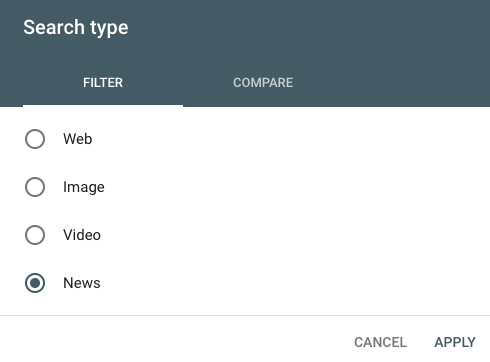
Local SEO
Local search results vary by the specific geographic region you are located. I am sure you have seen search results that look like the following:
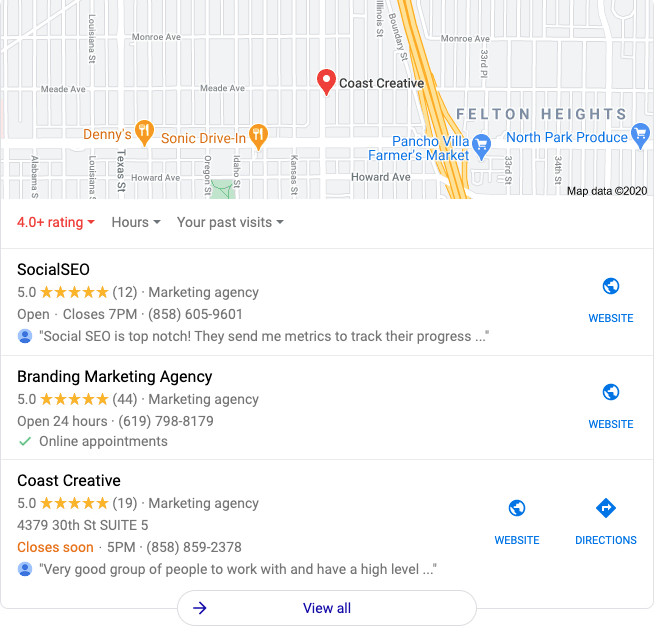
This is an example of the local pack results. I am located in San Diego, so your search results won’t look like what you see above for the same query.
The query I entered was “Best marketing agencies,” by the way. Regardless of where you are located geographically, there are specific ways to increase your rank for keywords that can trigger local results in the local pack.
To increase your Local SEO for your business in the local pack, you will have to utilize what is know by SEO professionals as NAP.
What is NAP?
NAP stands for Name, Address, and Phone number, which is used to build local citations around the web to give Google signals of where your business is located.
A Nap citation mentions your business name, address, and phone number on a locally relevant website. When you think of a local website, you more than likely think of Yelp, which is the right way to think about local SEO.
Outside of Yelp, many other highly local sites have several geographical segments across the US and international regions like Yelp.
NAPs ensure you have the correct format across different local websites. If your name, address, and phone number do not maintain consistently, it confuses search engines.
The most common issue with a local business that adversely affects local SEO is moving without updating addresses.
Imagine if someone searches your business just to be lead to an empty parking lot. Google realized they needed to help local businesses, so they created Google my business.
Google my business
The most important place outside of external local websites to ensure your NAPS are updated is Google my business.
GMB was explicitly designed for local companies to give Google directives to index your site accurately.
Google my business allows you to:
- Add a description of your business to appear in search results
- Manage reviews and messages
- Provide Q&A response for frequently asked questions
- Give directions
- Add images
And much more, here is an example of a Google my business search result listing that appears at the right of organic search results vs. the local pack that appears directly within search results.
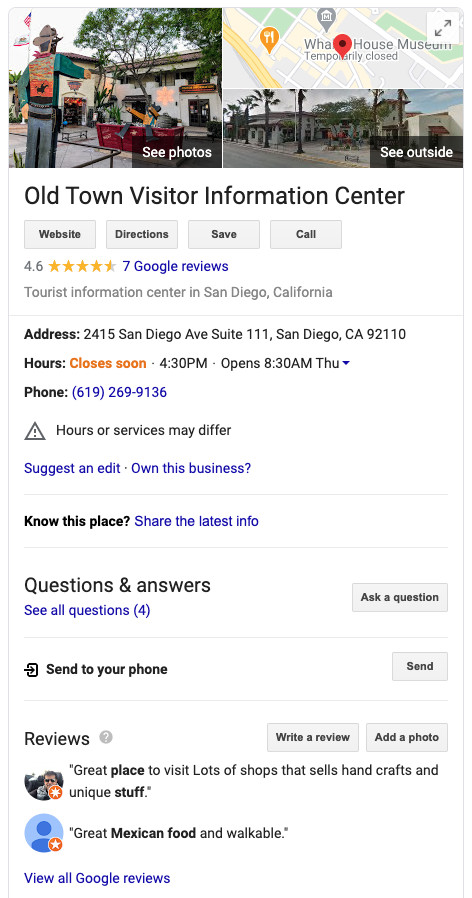
Google provides a streamlined user experience for local businesses to keep their listings up to date.
As a rule of thumb, consistently finding sites to place Nap citations on is a best practice for Local SEO.
Additionally, schema exists for local companies. Use the schema pro plugin to add local schema markup to your site.
New Google search features
One of the most exciting search features introduced by Google is Google Discover.
What is Google Discover?
Google Discover displays topics that interest you based on your search history. Topics are displayed with large images on the homepage of Google mobile search apps.
Here is what it looks like:

Google Discover produces high CTRs (click-through rates ) due to the large image formats. As much as 11% CTR was reported from data compiled from a very informative report compiled by Abby Hamilton.
How to appear in Google Discover
1.) Produce high-quality content
- Quote reputable sources
- Include data points
- Add semantic keywords (Variations of your target keyword)
2.) Use images
- Select high-quality images
- Use illustrative graphics (Infographics)
3.) Produce videos
- Embed Youtube videos
- Transcribe pre-existing videos
- Focus on how-to guides and interviews
4.) Follow Google’s content policies
Google has stated if you have any chance of appearing in Google Discover you must comply with their content policies.
5.) Implement AMP
Accelerated mobile page (AMP) will increase your odds of appearing in Google Discover. Remember, this feature was built for mobile devices.
6.) Publish trending content
Remember, I stated Google Discover is based on search history. Google seeks to provide the most up-to-date content based on what was previously viewed.
By providing timely articles/posts, will increase your odds of appearing in Google Discover.
Growth hack tip #2:
Research what competitors are currently appearing in Google Discover. Reverse engineer what they have done.
Additional Google search features
Job cards
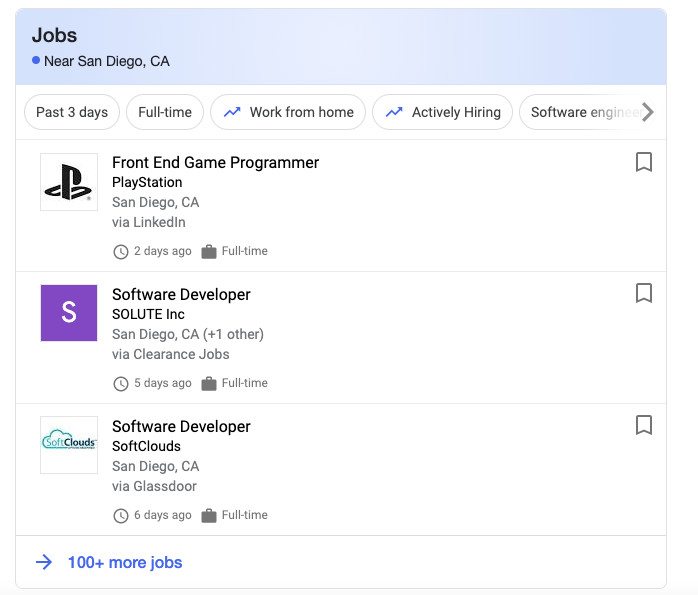
These search results are triggered when you type in search queries like “developer jobs” to populate these results.
If you are a company that is looking to hire freelancers or full-time employees, implement the job post schema markup type.
Event cards

If you type in a search query like “improv comedy shows,” you will see a search result like the one shown above.
Additionally, if you plan to host a webinar event on a specific date, you can help gain some early traction by adding event schema markup type.
Open graph meta tags

Google displays Twitter commentary. To potentially appear in these results, you will need to implement what is known as Open graph meta tags. Specifically, the Twitter open graph meta tag.
Google related search queries
Related queries contain a gold mine of great information for building out your content. These results are located at the bottom of the search results.
These queries show you what users are looking for as it relates to your target keyword.
Related questions are known as long-tail queries that carry more specificity toward your target keyword that can convert users at a higher rate.
Here is an example
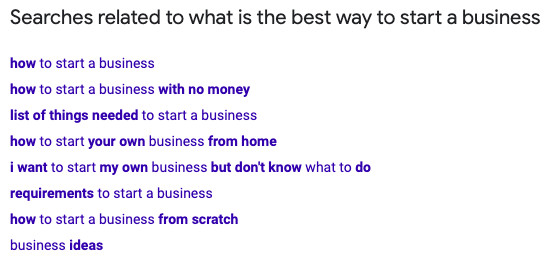
Long-tail keywords carry the power of user intent and should always be utilized to add additional context to your posts.
Long-tail keywords are one of the most underutilized tactics for big companies that primarily focus their efforts on generic keywords.
How to remove Google search results
There are two scenarios when it comes to removing search results from Google.
Scenario #1
You control the content you want to remove from Google search. Meaning you or someone within your organization has access to do the following.
- Delete the page appearing in the undesired search result
- 301 redirect the page appearing in the undesired search result
- No index the page appearing in the undesired search result
Out of the three options from a best practice SEO standpoint, you would want to go with option number 3 if you want the page gone from search.
How to no-index pages
To no-index a page, you can simply select no index from using the all in one SEO pack plugin for WordPress.
Simple, but scenario number two has a little bit more complexity towards a solution.
Scenario #2
You don’t control the content you want to remove from Google search. Meaning the search result you want to be removed is published on an external website.
So how do you go about removing something that does not belong to you? The answer is Reverse SEO.
What is Reverse SEO?
Reverse SEO is the practice of reverse engineering search results. When implementing this practice, you aim to push results off the first page of Google.
Why would you want to remove search results from Google?
Reverse SEO is used as a reputation management tactic in most cases.
How to perform Reverse SEO
There are three primary ways of how to perform reverse SEO.
- Ask for the removal of the content from the external site.
- Create more content around the specific query to our rank competitors.
- Promote competitors for the target search query.
The most ideal choice is option number one because options two and three can be very time-consuming.
Option three is certainly not ideal, but sometimes it is the most viable option in different scenarios.
The second option usually requires creating more authoritative content to outrank the negative search result to be effective.
Option two is the most utilized tactic when it comes to reverse SEO.
Reverse SEO scenario
Let’s say a client would like a Glassdoor review removed that is negative. To do this, you would have to leverage Glassdoor to write positive reviews.
By writing positive reviews on Glassdoor, the negative review will start to be pushed down on the platform.
Take a look at a typical Glassdoor review of how it appears in search results.

The review titles are usually shown, so pushing down specific negative reviews will show specific titles you wrote.
You may be saying to yourself, “That won’t last long because other people can write negative reviews, right?”
Yes, this is why companies hire reverse SEOs agencies to keep tabs on things like this.
If you need to implement reverse SEO for whatever reason, I urge you to be ethical.
Here is a recap of the best practices for SEO.
16 SEO best practices
- Deploy schema markup to be featured within search results.
- Add an image sitemap for Google to crawl your site for images.
- Create a video sitemap to increase your indexability of video content.
- Produce trending content to be featured in Google top stories.
- Leverage related Google search results to inform your content creation.
- Optimize your images by adding alt text, compressing file sizes.
- Avoid targeting high competition keywords focus on long-tail keywords.
- Remove unwanted results with the no-index tag in your robots txt file.
- Produce better content than competitors for the specific keyword targets.
- Make use of wikis to appear in the knowledge panel.
- Implement open graph meta tags.
- Follow best practices for on-site SEO
- Implement best practices for technical SEO
- Consistently build high-quality links as a best practice for off-page SEO
- Build NAP citations to influence the local SEO pack
- Use Google my business profile to index your site as a local business
Did you find this Step-by-step SEO guide useful? I would love to hear from you. What is the hardest part of SEO to you?
Make sure to share this article with others that can benefit from it🙂

A very in-depth article about SEO. Thank you for this amazing article.
What do you think is the first important Technical SEO factor for ranking our website? Is it maintaining HTTPs or maintaining a site structure?
Google has stated HTTPS is ranking factor, implement HTTPS first then focus on your site structure.The key is to focus on long-tail content clusters that ladder up to your harder-to-rank generic keyword terms. Best of Luck 🙂